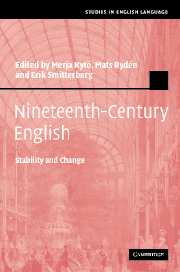Book contents
- Frontmatter
- Contents
- List of plates
- List of figures
- List of tables
- List of contributors
- Acknowledgements
- Introduction: Exploring nineteenth-century English – past and present perspectives
- 1 Modifiers describing women and men in nineteenth-century English
- 2 Words in English Record Office documents of the early 1800s
- 3 The subjunctive in adverbial clauses in nineteenth-century English
- 4 The passive in nineteenth-century scientific writing
- 5 Relativizers in nineteenth-century English
- 6 Anaphoric reference in the nineteenth century: that/those + of constructions
- 7 Adjective comparison in nineteenth-century English
- 8 Nonfinite complement clauses in the nineteenth century: the case of remember
- 9 The in -ing construction in British English, 1800–2000
- 10 Partitive constructions in nineteenth-century English
- Appendix
- References
- Name index
- Subject index
10 - Partitive constructions in nineteenth-century English
Published online by Cambridge University Press: 22 September 2009
- Frontmatter
- Contents
- List of plates
- List of figures
- List of tables
- List of contributors
- Acknowledgements
- Introduction: Exploring nineteenth-century English – past and present perspectives
- 1 Modifiers describing women and men in nineteenth-century English
- 2 Words in English Record Office documents of the early 1800s
- 3 The subjunctive in adverbial clauses in nineteenth-century English
- 4 The passive in nineteenth-century scientific writing
- 5 Relativizers in nineteenth-century English
- 6 Anaphoric reference in the nineteenth century: that/those + of constructions
- 7 Adjective comparison in nineteenth-century English
- 8 Nonfinite complement clauses in the nineteenth century: the case of remember
- 9 The in -ing construction in British English, 1800–2000
- 10 Partitive constructions in nineteenth-century English
- Appendix
- References
- Name index
- Subject index
Summary
Introduction
In English, partitive constructions are frequently used to quantify or characterize noncount and plural count nouns, as in (1).
(1) [$Gen.$] Why, I own your case is singular; but I'll give you a bit of advice, I have often received advice from you –
(Drama, Thomas Morton, 1800–30, p. 32)Such partitive constructions, or, simply, partitives, consist of a partitive noun followed by the preposition of and the complement of this preposition: in (1) above, bit is the partitive noun and advice the prepositional complement. Partitive constructions typically encode a part/whole relationship, where the partitive noun represents a part of the whole denoted by the complement. It is of interest to describe the use of partitives in English in order to enable future cross-linguistic comparisons. For instance, there are similarities between partitives and classifiers in classifier languages, such as Vietnamese (Svensson 1998: 200–2).
The aim of the present study is to analyse the use and distribution of partitive constructions in nineteenth-century English. The 1800s constitute an important period regarding the occurrence of partitives containing lot/s (Smitterberg 2003). The same time span could also be expected to have been important to the English partitive construction from a more general perspective.
Partitive constructions have not received a great deal of attention in the scholarly literature (Svensson 1998: 198): in order to open up this field of research more fully, I therefore adopt a broad methodological approach in the present study.
- Type
- Chapter
- Information
- Nineteenth-Century EnglishStability and Change, pp. 242 - 271Publisher: Cambridge University PressPrint publication year: 2006
- 2
- Cited by



